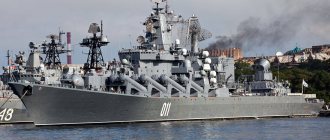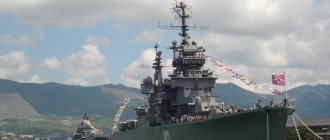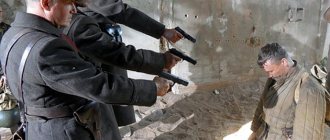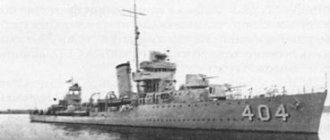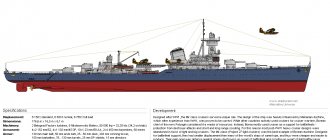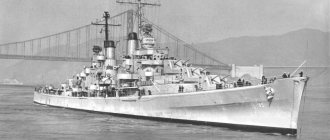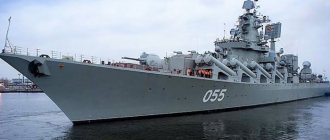Since childhood, we have all known the cruiser “Varyag” from one war song in which this ship is the main character who died in battle with superior Japanese forces during the war at the beginning of the 20th century. There is also another minor song, “Cold Waves Splashing,” but it is much less known. This song is also dedicated to the same event, and there is no contradiction in that.
The amazing fate of the ship was very ambiguous, and the truth about its feat was sacrificed to the demands of propaganda. Let's find out more.
American miracle of technology
By the time the Russo-Japanese War began in 1904, a “shaky” mood reigned in Russian society towards the future enemy. The defeat led to the opposite result: the technical achievements of the Japanese began to be exaggerated.
This trend also affected the assessment of Varyag. At first, the cruiser was characterized as a powerful military unit, capable of “outshining” the enemy. Later, allegations appeared that this cruiser was weak and outdated. Both statements are incorrect. It was not a matter of technology, but (as they would say today) a matter of the human factor.
Naval arms race
Japan at the end of the 19th century lagged behind developed countries in technical terms, but had already managed to make a tremendous economic breakthrough.
It did not reach the level of a world power, but it was worthy competition for the leading countries of the world. Further development required resources that were not available on the cramped islands - this explains the belligerence of the young “Asian tiger”.
In 1895, Russian intelligence received information about Japan's intention to increase its fleet so that it would be superior to Russian forces in the Pacific.
This should not have been allowed - Russia itself had expansionist plans in China and Korea. The order for the construction of the Varyag ship was one of the steps to prevent Japanese domination.
American order
Import substitution was not established - Russian shipyards worked slowly. Therefore, Philadelphia shipbuilders received the order to build the armored cruiser Varyag. They undertook to do everything in 20 months. The cruiser's guns were manufactured in Russia.
According to the project, these cruisers met all the latest (at that time) requirements for a warship.
The description of the ship's technical characteristics allows us to imagine a powerful, fast, well-armed ship.
- Overall dimensions: length – 129.56 m, draft – 5.94 m, width – 15.9 m.
- Displacement - 6500 tons (design), 6604 tons (actual).
- Armor: deck – from 37 to 76 mm, conning tower – 152 mm.
- The total engine power is 20 thousand liters. With.
- Maximum speed – 24.59 knots (obtained during testing).
- Main caliber – 152 mm (12 pcs.).
- Other artillery - 24 guns (75-, 63-, 47-, 37-mm), 2 machine guns.
- Other weapons: 6 torpedo tubes 381 mm, 2 * 254 mm, 35 barrage mines, 6 throwing mines.
- Team - 20 officers, 550 lower ranks (according to the staff). In real conditions there were changes; So, at the time of the battle with the Japanese, there were 558 people on the cruiser: 21 officers, 4 conductors, 3 hired civilians, a priest, 529 sailors.
The ship had a lot of electrical equipment (new for that time) - lifts for shells, winches for boats, even dough mixers. There was a telephone connection. The furniture was made of metal, although it was painted “for the ambiance” to resemble wood. This reduced the fire hazard.
Details not included in reports
The true history of the cruiser “Varyag” reveals facts that predetermined its short life. It was built and delivered to the customer in 1899 (that is, on time), but the flag over it was only understood on January 2, 1901. The reason is that the ship immediately required modifications - the tactical and technical characteristics did not correspond to what was planned.
There were two main problems. The Nikloss system boilers installed on the ship turned out to be unreliable and often broke down. Although the Russian fleet already had experience working with boilers of this system, and they did not cause any special problems, it didn’t work out here.
For this reason, in combat conditions the ship was slower than planned, and constantly ran the risk of ending up with emergency boilers at the most inopportune moment. In practice, the speed of 26 knots declared by the manufacturers was not achieved.
Usually the ship did not even give the speed of 24.5 knots shown during tests.
Captain V.F. Rudnev complained not only about problems with the boilers, but also about other shortcomings of the manufacturer, and about a weak repair base. Probably, his information about the maximum speed of 14 knots is understated, but the Varyag did not give full speed.
In addition, the armored cruiser's guns were deprived of armor protection. This created an additional risk for the gunners and the combat effectiveness of the cruiser (it was easy for the enemy to destroy the ship’s weapons).
This lack of armor protection played a fatal role in the famous battle of the cruiser Varyag with the Japanese squadron. Most cruisers of that time had such protection, but in this case the ship was made lighter due to gun armor.
From sad experience, appropriate conclusions were drawn; other cruisers of this type (including the Aurora) had gun protection installed. But this could no longer help the “Varangian” artillerymen.
The queen gave birth that night to either a son or a daughter...
The idea of what ships, namely cruisers, should be ordered was also quite vague. For a significant part of the 19th century, Russian sailors were preparing to fight with that same “shitty Englishwoman.” In the middle of the century they even fought a little. But in an open battle with the British Royal Navy, the Russian squadrons, even if they managed to somehow miraculously gather in the same sea, had little hope. As an asymmetric response, the doctrine of cruising war against the adversary's merchant fleet was traditionally adopted.
"Varyag" at the Philadelphia shipyard, 1899 (photo: Russian Navy)
Actually, the term “cruiser” itself initially referred to the ship’s ability to “kruisen,” i.e., to cruise, and not to tactical and technical data. In the Russian Imperial Navy, the required characteristics were formulated something like this: a cruiser must sail very far and for a long time, be fast enough to escape from a stronger enemy, and strong enough to annoy a weaker one. The combination of the last two qualities, in theory, would allow the ship to also serve as a high-speed reconnaissance aircraft for the squadron.
We must pay tribute to the admirals - as new cruisers were being built, they began to think that if the enemy was not only “merchants”, then it would be painful for new ships to arrive often. Therefore, on later cruisers, the guns began to be covered with shields, or even removed into casemates or armored turrets.
One of the Varyag’s guns (photo: Russian Navy)
"Varyag" was the first in the series, so its guns were open. Perhaps, even in this form, he could screw up one of the many British 2nd class cruisers of an earlier construction (Japan purchased such ships from Great Britain for its fleet). Unfortunately, the Japanese did not limit themselves to such ships; they also purchased from England armored cruisers of the Chilean design, which became the Asama class - one and a half times larger than their predecessors and much better armed and armored.
Improvements during service
Throughout its life, the Varyag underwent major modernization twice. The first was produced by the Japanese, who raised the cruiser in 1905. During the repairs, the chart room, pipes, fans, navigation bridges were changed, mine net poles and top platforms were removed. The 75mm guns were replaced with 76mm Armstrong guns.
After the return of the Russian ship in 1916, the bow and stern main caliber guns were moved to the center plane, resulting in an increase in the power of the broadside salvo.
The machine guns were converted to fire at air targets. Dead moves have been eliminated in the mechanics. And most importantly, the artillery received partial armor protection (shortened shields) - conclusions were drawn from the past.
Cruiser design
"Varyag" was created as a ship superior in its combat qualities to "Diana" or "Aurora", which were actually already outdated by the beginning of the Russo-Japanese War.
Indeed, the project of the new cruiser turned out to be quite advanced for the beginning of the 20th century. Unfortunately, at the same time, a number of miscalculations were made during the construction of the ship, which sharply reduced its real combat effectiveness.
Frame
The “backbone” of the cruiser was the keel, which connected the bow and stern stems (massive bars cast from bronze) and consisted of steel profiles and sheets. The so-called floras (transverse sheets forming the frame of the lower part of the ship) were attached directly to it. A second bottom was laid on top of the resulting structure, which extended the entire length of the hull and served as a good support for the power plant and various mechanisms.
The second “roof” of the hull was formed by a massive armored deck, which simultaneously served as the main element of protecting the ship from enemy artillery fire. In the bow of the cruiser there was an elevation (forecastle). Thanks to this, the Varyag could successfully overcome large waves formed during a storm and not lose longitudinal stability. The total height of the hull reached 10.46 meters with a design weight of 2,900 tons.
Armored deck
Protection of the interior of the cruiser was provided by interconnected armor plates with thicknesses of 38.1 and 19 mm, forming a single armored deck, which, because of its configuration, was called “carapace” (that is, turtle-like). It covered the ship not only from above, but also along the sides, dropping 1.1 meters below the waterline. The elevation of the armored deck above the engine room was 7.1 m, and above the main line of the hull - 6.48 m.
The sides of the Varyag were additionally protected by so-called cofferdams - waterproof compartments between the armored deck and the outer skin. Coal pits were adjacent to them on the inside.
Thus, the damage received when a shell hit the side could be localized without fatal consequences for the ship - even penetration of the armor itself did not lead to damage to vital mechanisms. The rubber dams had no internal contents, although at first they wanted to fill them with cellulose.
Powerplant and propellers
The cruiser "Varyag" was driven by steam engines, the maximum power of which was 20 thousand horsepower, but due to a number of technical reasons this value was never achieved in practice. The operation of the power plant was ensured by thirty Nikloss boilers located in three compartments: 10 in the bow, 12 in the stern and 8 in the middle.
It should be noted that in the last years of the 19th century, Nikloss boilers were a novelty, differing from previously used and similar devices, first of all, in their relatively low weight. The initiator of equipping the Varyag with such boilers was Charles Crump. In the future, this decision turned out to have quite unpleasant consequences, causing numerous breakdowns.
Two three-blade propellers with a pitch of 5.6 meters were used as propulsion devices for the ship. For the initial rotation of the shafts to which they were connected, the cruiser had a kind of “starters” - auxiliary two-cylinder steam engines.
Electrical equipment
A significant part of the mechanisms of the cruiser "Varyag" was equipped with electric drives. In addition, there was a lighting system, a desalination plant and other equipment on board, which also required electricity. The total consumption was more than 400 kilowatts - a lot for a ship of this size at that time.
Energy generation was carried out by three dynamos. One of them was on the living deck, and the other two were on the bow and stern. If they failed, power could be provided according to an emergency circuit, from sixty batteries placed in a special compartment.
The list of main consumers of electricity is as follows:
- Fans (boiler rooms, machine and general ship fans). During operation, up to 119.2 kW was used;
- Lighting. A total of 700 lamps, in nominal mode half of them were turned on, consuming 22.4 kW;
- Gun elevators. Consumed up to 33.3 kW at half load;
- Sump pumps. There were six of them, but usually only one was connected, consuming 40 kW;
- Spotlights. Required 54 kW;
- Winches (boat, garbage and for lifting anchors). Consumed a total of 136.1 kW.
In addition, electricity was used in the galley to operate dough mixers and for other purposes.
Ventilation system
The ventilation on the cruiser "Varyag" was quite powerful and well developed. Particular attention was paid to the engine rooms - the air in them was completely renewed twenty times within an hour. True, when moving at full speed, the temperature inside these rooms still reached forty-three degrees or even more.
In the artillery cellars, an hourly twelve-fold air renewal was provided, and in the remaining internal rooms located under the armor - five-fold. The room allocated for the bow dynamo was the worst ventilated, which is why the temperature inside it often reached 55 degrees.
Life support systems
The cruiser's crew was located mainly on the living deck and partly in the bow, directly under the forecastle.
The “lower ranks” were provided with hanging bunks, which were removed during the day, and lockers. The sailors used folding tables for meals.
The best conditions were created for the ship's commander. The premises allocated for it occupied the aft part of the living deck, which extended 12 meters in length. The cabins for officers were single, their area was six square meters. The conductors were accommodated in double cabins. The chief navigator, senior mechanical engineer and senior officer were in slightly better conditions - their cabins had an area of 10 sq.m.
In addition, on the living deck there was an infirmary with a separate operating room, a pharmacy, a bathhouse and a ship's church. There were also two wardrooms - for officers and conductors.
Cruiser "Varyag": death and immortality
On January 27, 1904, the cruiser of the Russian Imperial Navy “Varyag” left the Korean port of Chemulpo. When the ship left the raid, the orchestra lined up on the deck, first played the Russian anthem, and then, passing by the English, French and Italian cruisers, as if saying goodbye, played their anthems. In the wake of the Varyag was the gunboat Koreets. The Russian sailors wanted to break through to their own, in Port Arthur, but they knew that ahead lay an archipelago of small islands, between which they needed to pass along a narrow and shallow fairway, and behind the islands a squadron of Japanese ships was waiting for them.
1st rank armored cruiser "Varyag"
On the eve of the war
The light reconnaissance cruiser "Varyag" was a very large ship for its time - with a displacement of 6,500 tons, a speed of 17 knots and quite powerful weapons. Built in the USA at , it was launched in 1899. The cruiser was commanded by Captain 1st Rank Vsevolod Fedorovich Rudnev.
Captain 1st Rank Vsevolod Rudnev, commander of the cruiser "Varyag"
The gunboat "Koreets", significantly inferior to the "Varyag" in displacement and speed, was much older than it. The gunboat was commanded by Captain 2nd Rank Grigory Pavlovich Belyaev.
Captain 2nd Rank Grigory Belyaev, commander of the gunboat "Koreets"
Since the end of 1903, “Varyag” and “Koreets” were present in the neutral port of Chemulpo as stationary ships (ships constantly on the roadstead) in order to protect the Russian embassy in Seoul. From mid-January 1904, the situation in Chemulpo became more alarming and tense every day. One could feel the approach of war: the Japanese seized the telegraph in the port, intercepted and censored Russian mail. On January 23, Rudnev heard rumors about the severance of diplomatic relations between Japan and Russia. However, neither he nor the Russian envoy in Seoul, Alexander Pavlov, had any official information about this.
Port blockade and Uriu ultimatum
In such a situation, it was urgent for Russian ships to connect with their squadron in Port Arthur. On the other hand, official instructions prescribed not to leave Chemulpo without an order. Finally, Pavlov agreed that only “Korean” would go to Port Arthur with a secret report. On January 26, the gunboat left Chemulpo, but it was too late: it was on that day that the port was blocked by a Japanese squadron. Having traveled less than two miles, the Korean collided with enemy ships - there were more than a dozen of them. Two Japanese destroyers fired three torpedoes at the gunboat: two of them passed behind the stern of the Korean, and the third sank.
The gunboat was forced to return back to Chemulpo. There, Belyaev informed Rudnev about the Japanese attack, and the Varyag commander immediately gave the order for increased combat readiness. Feverish work began on the ship: the sailors began to batten down the doors and necks, feed shells from the cellars, check fire hoses, prepare dressing stations...
On the morning of January 27, the commanders of foreign stationers in Chemulpo received a notification from the commander of the Japanese squadron, Rear Admiral Sotokichi Uriu: saying that Japan and Russia were at war, he suggested that the Russian ships leave the raid before noon, warning that if they did not leave Chemulpo, the Japanese the squadron will open fire on them right in the port.
Commander of the Japanese squadron, Rear Admiral Sotokichi Uriu
Gathering on the English cruiser Talbot, the commanders of all stationers signed a protest against the violation of Korean neutrality and sent it to Uryu. Fearing a possible battle, they decided to take their cruisers further away, deeper into the bay. And, citing the same neutrality, the foreign commanders declared that they would not accompany Russian ships to neutral waters. They preferred to “wash their hands of it.”
"Let's go for a breakthrough"
Returning to the Varyag, Rudnev held a meeting with the officers. They unanimously spoke out in favor of breaking through to Port Arthur. Having lined up the personnel on deck, the caperang addressed the sailors: “Of course, we are going for a breakthrough and will engage in battle with the squadron, no matter how strong it is. There can be no questions about surrender - we will not surrender either our ships or ourselves and will fight to the last opportunity and to the last drop of blood. Perform each duty accurately, calmly, without haste, especially gunners, remembering that each projectile must harm the enemy.”
At nine o'clock in the morning the teams of "Varyag" and "Korean" began preparing for battle. Later, those sailors who were lucky enough to survive will talk about the incredible inspiration that gripped the crew, about that strange state - excited-evil and at the same time fiercely cheerful - in which everything is done quickly, deftly and quickly. The ship's doctor Mikhail Banshchikov writes in his book: “I remember with reverence the unforgettable picture of this general enormous uplift of spirit; there seemed to be no barrier to these transformed people.” The patients who were in the infirmary voluntarily returned to duty; not a single civilian agreed to go ashore and take refuge in the consulate. “We’re all going to die together!” – the ship’s cook Akim Krishtofenko expressed the general mood.
At 11:10 a.m., “Varyag” and “Koreets” weighed anchor. Their crews lined up on the decks of foreign cruisers, saluting the departing Russian ships. Later, Victor Sanes, the commander of the French Pascal, would write in an official report: “We saluted these heroes who marched so proudly into a hopeless battle, to certain death.”
"Varyag" and "Korean" go into battle. January 27, 1904
“And our fearless and proud “Varyag” became like pitch hell ... "
The Japanese squadron - 6 cruisers and 8 destroyers - lay in wait for Russian ships 10 miles from Chemulpo. In a narrow fairway, strewn with pitfalls, it had to follow a strictly defined course, at low speed, turning, in fact, into an ideal target. The Russian cruiser did not respond to the surrender signal from the Japanese flagship. At 11:45 a.m., the first shots were fired by the Asama, a Japanese armored cruiser, one of the best in the world at that time, three times superior to the Varyag in the power of its broadside. In response, guns thundered on the starboard side of the Russian cruiser.
The first killed and wounded appeared on the Varyag; An enemy shell destroyed the upper bow bridge and fires started. Many sailors, having received burns, did not go to dressing stations. “During the entire battle,” recalled Mikhail Banshchikov, “I positively did not see a single easy case. The lightly wounded began to come for dressing only upon returning to the roadstead, when the battle was over.”
"Varyag" fought for one hour. During this long and terrible hour, the ship and its crew seemed to merge into one living body, into a single organism, working with crazy, transcendental energy. This hour elevated all crew members to the rank of heroes: midshipman Alexei Nirod, killed at the end of the battle; boatswain Timofey Shlykov, who appeared wherever the situation became especially difficult; gunner Kuzma Khvatkov, who commanded the gun, although two days before the battle he underwent surgery; midshipman Chernilovsky-Sokol, who led the fire extinguishing; midshipman Gubonin, who was seriously wounded but remained at the gun; doctors, paramedics, orderlies... All team members remained at their vehicles, guns, boilers, fire hoses, at dressing stations, everyone showed the highest courage and self-control.
Boris Livanov as Vsevolod Rudnev in the Soviet film “Cruiser “Varyag”” (1946)
Return to the port of Chemulpo
During the hour of battle, the Varyag fired 1,105 shells at the enemy. Two Japanese cruisers, Asama and Chiyoda, were seriously damaged. However, the number of damage on the Varyag itself was rapidly increasing, and personnel losses were increasing. A large shell pierced the stern, water poured into the hole, and the ship began to list to the left side. At 12:45 p.m., the Varyag turned back to the roadstead.
Having lost a significant part of its personnel, with several large holes, covered in clouds of black smoke, tilted heavily to the left side, wounded and mangled, but not defeated, the cruiser at 13:15 minutes again appeared in the roadstead, where no one expected to see it again. “I will never forget,” the captain of the Pascal, who immediately arrived on the Russian ship, would later write, “this stunning sight: the deck is covered in blood, corpses and body parts are lying everywhere... In the places where the shells exploded, the paint was charred, all the iron parts pierced, the sides and bunks were burnt... Where so much heroism had been shown, everything was rendered unusable, broken into pieces, riddled with holes; smoke was coming from the holes in the stern, and the list to port was increasing.”
"Varyag" after the battle, shortly before the sinking
It was decided to blow up both ships to prevent their capture by the Japanese, and place the personnel on foreign cruisers. The “Korean” was detonated at about 15:00.
Explosion of the gunboat "Korean"
Since foreign commanders feared that the wreckage of the Varyag would damage their ships, Rudnev changed his mind and ordered the cruiser to be scuttled. When all the valves and seacocks were open, the caperang was the last to leave his ship. After 2.5 hours, “Varyag” went under water...
"Varyag" after the battle, abandoned by the team
Like a phoenix
The surviving sailors had to go to St. Petersburg. The first echelon of Varangians arrived in Russia on March 19, 1904. In Odessa, Sevastopol, Moscow and St. Petersburg, a reception of unprecedented enthusiasm and inspiration awaited them.
Heroes of Chemulpo are welcomed in Odessa
The crews of the "Varyag" and "Koreyets" pass along Nevsky Prospekt in St. Petersburg
In the capital of the empire, ceremonial events followed one after another: a meeting at the Nikolaevsky station, a march along Nevsky Prospekt, where it seemed that the entire population of the city had gathered, a royal review on Palace Square, a prayer service and lunch in the Winter Palace, a meeting regarding the establishment of a special medal “For the battle between the “Varyag” and the “Korean”, the presentation of gifts from the City Duma - each sailor received a personalized silver watch...
Medal “For the battle of “Varyag” and “Korean””
Rudnev, Belyaev and the entire officer corps of the two ships were awarded the Order of St. George, IV degree. It is worth mentioning that Emperor Mutsuhito awarded Rudnev the Order of the Rising Sun in 1907 - the Japanese were so impressed by the fortitude and courage of the Russian sailors. Vsevolod Fedorovich accepted the award, but never wore it.
As for the Varyag, its life did not end in January 1904. The Japanese raised the ship, repaired it and commissioned it under a new name - Soya. In 1916, Russia bought the cruiser from Japan. In February 1917, the Varyag went to England for repairs - and the British simply captured it after the October Revolution. A year later, the cruiser crashed after hitting rocks in the Irish Sea. But, apparently, this ship has some special destiny and “karma” - to be reborn again and again, like a Phoenix from the ashes: many years later, one of the most powerful missile cruisers of the Soviet Pacific Fleet will be named after it.
Missile cruiser of the Pacific Fleet "Varyag"
Years and decades pass, political systems and structures change, entire civilizations collapse, but “Varyag” remains immortal...
Header photo: Armored cruiser 1st rank "Varyag"
Composition of weapons
The main armament of the cruiser "Varyag" was twelve six-inch (152 mm) guns with barrels 45 calibers long. They were divided into two batteries - bow and stern, with six guns in each. The main caliber guns were loaded separately (a cartridge case with a charge of smokeless powder and a projectile). The ammunition load was a total of 2388 rounds, 199 per gun.
The main artillery was supplemented by a third battery, consisting of twelve 75 mm guns. They were loaded with unitary cartridges, the total number of which was 3000 pieces, 250 shots for each gun.
The Varyag’s “counter-destroying” artillery consisted of eight 47 mm and two 37 mm guns firing unitary cartridges. The ammunition load for these guns was 5,000 and 2,584 rounds, respectively.
In addition, the ship had two 63.5 mm cannons on wheeled carriages. They were not intended for naval combat, but to arm landing forces and could fire directly from the boats. The ammunition load for these guns included 1,490 unitary rounds.
Two 7.62 mm machine guns were mounted on brackets near the conning tower. They were intended to fire at enemy boats and destroyers.
The cruiser was equipped with six torpedo tubes (381 mm). Four of them were rotary and placed on the sides of the ship. There were stationary devices at the bow and stern. The ammunition load consisted of twelve torpedoes.
When performing landing and auxiliary operations, the Varyag could launch two steam boats. They were provided with separate 254 mm torpedo tubes. Ammunition: six torpedoes, three for each boat.
The cruiser's armament also included 35 barrage mines. They had to be installed using boats and rafts. This method was generally accepted in those years.
Unfortunately, we have to admit that at the beginning of the 20th century, six-inch guns were no longer considered powerful enough to arm ships of such a class as the Varyag. This significantly reduced the real capabilities of the cruiser. The refusal to install larger eight-inch guns was caused by the desire to make the ship as light as possible - otherwise it would not be able to reach its design speed.
At the same time, the main disadvantage of the Varyag’s artillery was its open placement on the upper deck. The cannons did not have even the most primitive shields - they were removed, trying to reduce the weight of the ship as much as possible. As a result, the artillerymen found themselves in a very vulnerable position during the battle.
Performance characteristics
The main parameters of the cruiser "Varyag" are as follows:
| Displacement | 6604 tons |
| Ship length | 129.56 m |
| Width | 15.9 m |
| Draft | 5.94 m |
| Maximum speed | 24.59 knots |
| Economic speed | 10 knots |
| Fuel reserve | 1350 tons (coal) |
| Cruising range | 3270 miles at normal load, up to 6100 at maximum |
| Crew | 580 people (including 21 officers, including the commander) |
The Varyag could not always reach its maximum speed, which was due to the unreliability of the boilers, which had to be repaired almost every time after intensive use.
Blockade of the Russian fleet in a Korean port
By the winter of 1904, Russian-Japanese relations had become so tense that war between the two states was virtually inevitable. The cruiser "Varyag" under the command of captain 1st rank Vsevolod Fedorovich Rudnev and the gunboat "Koreets" under the command of captain 2nd rank Georgy Pavlovich Belyaev were on duty at the port of Chemulpo at that time.
Since Korea's diplomatic status in the upcoming war remained unknown, Russian sailors were entrusted with the mission of protecting the embassy and Russian citizens located in nearby Seoul. In addition to warships, the Russian transport ship Sungari was stationed in the port.
Korea decided to remain neutral in the war, and on February 6, 1904, Japan broke off diplomatic relations with Russia and sent a powerful military squadron to Chemulpo.
The flotilla of the Land of the Rising Sun consisted of six cruisers and eight destroyers and exceeded the total strength of the Varyag and the Korean by at least four.
Had the captain of the Varyag Rudnev known about the severance of diplomatic relations, the death of the ship could have been avoided. However, Japan intercepted telegraph messages passing through Korean territory - the Russian fleet found itself in an information blockade. Nevertheless, Rudnev received news about what was happening from the sailors of foreign ships located in the port of Chemulpo.
At a general meeting at the Russian Embassy in Seoul on February 8, 1904, it was decided to send the gunboat “Korean” to Port Arthur for orders and instructions.
The postal mission failed at the very beginning. As soon as it left the port, the gunboat came under a torpedo attack from a Japanese squadron and was forced to turn back. The only exit was blocked, the Russian fleet was blockaded.
The fate of the cruiser "Varyag" in the early years
The fate of the cruiser "Varyag" began at the docks of the North American port of Philadelphia. The ship was built by an American company commissioned by the Russian government from April 1898 to September 1900. Immediately after launching, the cruiser was included in the Navy of the Russian Empire. In March 1901, the ship departed across the Atlantic Ocean to Kronstadt. On August 5, 1901, the cruiser left the Kronstadt port and escorted the yacht of Emperor Nicholas II to the city of Cherbourg in northern France. Then the cruiser went to the Far East through the Mediterranean Sea, the Suez Canal and the Indian Ocean. On February 25, 1902, the Varyag arrived in Port Arthur. The Russian government leased this port, which does not freeze in winter, from China in 1898. The cruiser was left in military reserve and was used until the beginning of the Russo-Japanese War.
The armored four-tube cruiser of the 1st rank "Varyag" was in service with the Navy of the Russian Empire from 1901 to 1904. The ship was part of the 1st Pacific Squadron and was based in the Port Arthur roadstead in the Yellow Sea.
The last battle of “Varyag” and “Korean”
On the morning of February 9, 1904, Japan officially entered the war with Russia. The commander of the Japanese squadron, Rear Admiral Sotokichi Uriu, received permission from his government, if necessary, to attack Russian ships even on neutral territory - in a Korean port. This is what he informed all the captains of foreign ships anchored in Chemulpo, and, despite their protests, he remained firm in his decision.
The captain of the cruiser "Varyag", on the contrary, was shocked by the current situation, which probably influenced all his subsequent decisions. Having received an ultimatum from Rear Admiral Uriu ordering him to leave the port or be attacked right at the anchorage in the neutral waters of Chemulpo, Rudnev decided to break through to Port Arthur.
Closer to lunch, the cruiser "Varyag" and the gunboat "Koreets" went out to the open sea in full combat readiness. The Japanese squadron was at anchor and was not prepared for such a turn of events - Rear Admiral Uriu was sure that the Russians would not leave the port. However, the Japanese hastily unfastened the anchor chains and went to intercept.
About an hour later, the first shells whistled in the air, the enemy opened artillery fire, and the Russian ships responded in kind. The Japanese concentrated almost all their fire on the Varyag, since the slow-moving gunboat Koreets posed less of a threat due to its outdated guns.
Soon the enemy broke through the bridge located at the stern of the Varyag, which caused a fire. Then one of the enemy shells destroyed the rangefinder station in the bow of the ship. Half an hour after the start of the battle, the Varyag, having described a wide arc, took the opposite course and began to return to Chemulpo. During the maneuver, the cruiser received the most hits. However, both Russian ships returned to port.
The Japanese ships pursuing the fugitives ceased fire so as not to damage neutral ships. Returning to the port, Captain Rudnev decided to destroy all Russian ships so as not to hand them over to the enemy. All surviving sailors and officers were evacuated from the damaged cruiser Varyag to the ships of neutral powers. Then the kingstons were opened, the cruiser fell on its side and sank.
Apart from a minor hole, the gunboat "Koreets" was practically not damaged in the battle, the entire crew remained safe and sound. However, it was pointless to engage in battle; the boat was mined and blown up. In addition, the Sungari steamer was set on fire and sank.
The fate of the cruiser and crew after the battle
Often on the Internet and other popular sources they write about the “heroic death of the cruiser Varyag”, about its last signal “I’m dying, but I’m not surrendering” and about how “the crew sank the ship so that it would not fall to the enemy.”
However, the whole feat of the Russian sailors was that they did not accept the first Japanese offer to leave the Korean port without a fight. The armored cruiser "Varyag" and the gunboat "Koreets" set out on an external raid against a much superior enemy. After retreating to the bay, by decision of the general meeting of officers, the cruiser was sunk in shallow water. According to eyewitnesses, the water did not even cover the deck of the ship. Therefore, it was not difficult for the samurai to raise and restore the ship. In August 1905, the cruiser was turned into the training ship Soya, and the flag of the Rising Sun flew on its flagpole.
The team went ashore and actually found themselves in Japanese captivity. The sailors and 1 midshipman who died in battle were buried on Korean soil. The wounded Varangians were treated at the local Red Cross hospital and on foreign ships. Then, having given the Japanese side a written commitment not to participate in hostilities, the Russian sailors returned to Odessa through neutral ports.
In Stalin’s time, for the voluntary capture and surrender of a warship, sailors would have been declared enemies of the people, and each would have faced either capital punishment or camp labor. But the Tsar-Father was more lenient towards his subjects. And the war was not the same...
At home, the Varyag crew members were greeted as heroes. This was done for propaganda purposes. The tsarist government needed a “small victorious war” to raise its own prestige. On April 16, 1904, the Varangians marched through St. Petersburg from the Nikolaevsky railway station to the Winter Palace. Emperor Nicholas II himself arranged unheard-of honors for them. The sailors were invited to dinner at the royal palace. Everyone was given lunch sets and a personalized wristwatch as a gift.
Sailors of the cruiser "Varyag" with gifts. The inscription “Varyag” is clearly visible on the bellies, and on the left side of the jacket is the Military Order of the 4th degree, which was awarded to all lower ranks
Heroic retreat?
The results of the battle were not encouraging. The Japanese squadron actually suffered no losses. The cruiser "Varyag" was not blown up, but, along with documents and weapons, carefully lay down on the bottom at a shallow depth and soon joined the flotilla of the zealous Japanese.
In the report, the commander of the Varyag, Rudnev, explains the turn of the cruiser at the height of the battle as an attempt to briefly get out from under fire to repair the ship’s control mechanism and extinguish the fires that had arisen on board. However, the Japanese commission in charge of raising the cruiser from the bottom did not find any malfunctions.
In addition, in his report, the commander of the Varyag clearly exaggerated the number of salvos of deck guns. According to his information, 425 shells of 152 mm caliber were spent, but the Japanese, after conducting an audit on the captured ship, calculated the consumption not exceeding 160 pieces.
According to the recollections of one of the Varyag officers, Rudnev expected that a tribunal would await all of them upon returning to their homeland. However, Nicholas II, on the contrary, awarded everyone who took part in the battle, which caused extreme bewilderment among the officers of the tsarist army. The high command rightly believed that heroic deeds involved more than simply being on board a ship.
Interestingly, the Emperor of Japan Matsuhito also highly appreciated the heroism of the captain of the Varyag, and in 1907 he awarded him the Order of the Rising Sun, second degree. Rudnev accepted the award, but, according to the recollections of his contemporaries, he never wore it.
The cruiser's return to her homeland and her last voyage to Europe
During World War I, Russia and Japan were allies. The latter agreed to sell warships once captured from the Pacific squadron. Among them is the cruiser “Varyag”. In the summer of 1916, the cruiser made the transition from Vladivostok to Murmansk. In November of the same year, it was transferred to the allied England for repairs. However, the Soviet government that soon established refused to pay Britain for the debts of the Russian Empire. The British confiscated the ship and sold it for scrap to Germany in 1920.
Interesting Facts
After the feat of the crew of the cruiser "Varyag", the German writer and poet Rudolf Greinz wrote the poem "Der "Warjag"" dedicated to this event. It was published in the tenth issue of the German magazine Jugend. In Russia, it was translated into Russian by Evgenia Studenskaya.
Soon, the musician of the 12th Astrakhan Grenadier Regiment, Turishchev, who took part in the ceremonial meeting of the heroes “Varyag” and “Korean”, set these poems to music. The song was first performed at a gala reception given by Emperor Nicholas II in honor of the officers and sailors of the Varyag and the Korean. The song became very popular in Russia.
